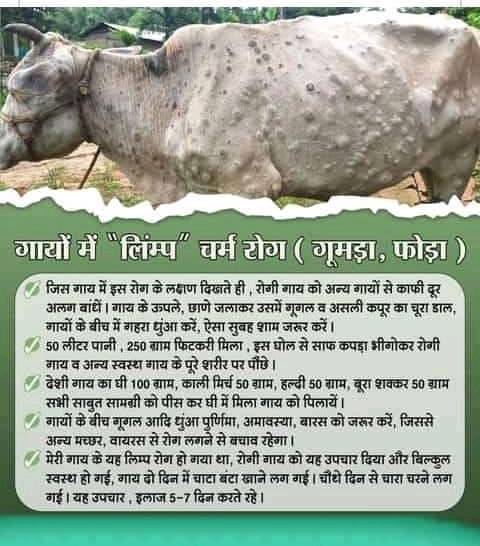‘Lumpy skin disease not endemic yet, can be controlled via vaccination’: Prof J B Kathiriya
Lumpy skin disease (LSD) is a viral disease that affects mostly cows of both indigenous breeds as well as the exotic.
Written by Gopal B Kateshiya |
J B Kathiriya, Assistant Professor, department of veterinary public health and epidemiology, College of Veterinary Science and Animal Husbandry, Junagadh.
Lumpy skin disease, a viral infection mainly affecting cattle and buffalos, has spread to 14 out 33 districts of Gujarat with more than 40,000 confirmed cases and around 1,000 deaths. In an interview with Gopal Kateshiya, Prof J B Kathiriya, Assistant Professor with the department of veterinary public health and epidemiology of Kamdhenu University’s College of Veterinary Science and Animal Husbandry in Junagadh, speaks about the disease and how it can be controlled. Edited experts of the interview:
What is the lumpy skin disease?
Lumpy skin disease (LSD) is a viral disease that affects mostly cows of both indigenous breeds as well as the exotic. The exotic breeds of cattle like Jersey and HF are more susceptible due to their low immunity levels as compared to indigenous breeds. The LSD also affects buffaloes but not on the scale it does to cattle as buffalos have higher immunity levels as compared to cattle.
What virus causes LSD? Where did it originate from?
LSD is caused by a virus called lumpy skin disease virus (LSDV) of capripoxvirus genus in the poxviridae family, where capri means goat. The LSDV has origins in Africa and it has been there in that continent for around 100 years now. The African Cape buffalo is possibly the reservoir of this virus in the wild. LSDV has a limited host range and it doen’t infect non-ruminant animals. However, even after coming in close contact with infected cattle,sheep and goats never develop LSD. In Asia, it was first reported in China in 2019, then in Bangladesh and in India. The viruses remain present in the environment and strike when their victim’s immunity goes down. Just like in Covid-19, some people don’t develop any symptoms while others become seriously ill.
How does LSDV spread?
This is primarily a vector-borne disease. It is spread by blood-sucking vectors like mosquitos, ticks, houseflies etc. When these vectors bite healthy cattle after biting infected cattle, the virus is transmitted from one cattle to the other. Sometimes, the LSD spreads through direct close contact also. It also spreads through direct contact with the mucus of the infected cattle. Cattle of all breeds and both sexes and of all age groups are susceptible to LSDV. However, younger animals may be more susceptible to the severe form of the disease. Its spread in Saurashtra coincides with persistent rainfall. During such weather, animals remain stressed and remain susceptible to viral diseases.
And how does the virus impact health of animals?
The virus attacks the circulatory system of the animal and thus affects all vital organs of the animal. But it attacks the skin of the animal the most and as a reaction, lumps emerge on the skin of the infected animals. The lumps or nodules cause irritation to animals, consuming a lot of energy of the infected bovine. Sometimes animals go down with fever. All these things put an animal under stress and the animal reduces its food intact. Consequently, milk production reduces by average 20 per cent.
Is there treatment available for LSD?
Yes. LSD is curable and recovery will be fast if treatment is given at early stages of the infection. Cattle start developing symptoms from the second or third day after contracting LSDV and if treatment is given immediately, the animal can recover within a week.
Can an animal survive LSD without treatment?
It depends on the immunity levels of an infected animal. Research has shown that an animal with average immunity level can recover within two weeks without any treatment, with symptoms peaking on around 10th day. While LSD rarely causes deaths on its own, the infection compromises immunity, making the animal susceptible to other infections. Combination of LSD with other infections may prove fatal. Generally, 10 per cent mortality has been observed in LSD.
So, will the milk produced by infected animals be safe for human consumption?
Absolutely, but with certain precautions. LSDV is a very fragile virus and without their host, it dies at around 37 degrees. So, milk produced by an infected animal will be fit for human consumption after boiling or pasteurisation as these processes will kill the viruses, if any, in the milk.
What precaution should dairy farmers/cattle-herders take?
The first thing is, they should sanitise cattle-sheds by eliminating vectors through application of insecticides and spraying disinfectant chemicals. They should isolate the infected cattle immediately from the healthy stock and contact the nearest veterinarian for treatment of the infected animal. This is necessary as otherwise the virus may prove fatal. Secondly, they should report the outbreak to the state government so that the rest of the healthy herd can be vaccinated by goat pox vaccine.
Are dairy farmers/cattle-herders taking care of infected animals at risk?
Not particularly. LSDV doesn’t remain viable, meaning alive, on inanimate surfaces like soil or water beyond five to 10 minutes and there have been no cases of the virus jumping to humans.
The government protocol says ring-vaccination of cattle in a radius of five kilometers from the epicenter of an outbreak. Why not vaccinate the entire cattle population?
Livestock population of Gujarat is huge—third or fourth largest in the country—and vaccinating the entire population can prove to be a daunting task. Secondly, universal vaccination of cattle is not needed as, while LSD is a new disease, it is not endemic as of now.
And how effective is the goat pox vaccine?
The vaccine available in India has around 70 per cent efficacy. Antibodies develop in an animal three weeks after the animal is given a dose of vaccine and they generally last for six months.
So, will a cow infected by LSDV always be a carrier of that virus even after recovery?
No. In normal cases, an infected animal will be a carrier of LSDV at the most for 20 to 30 days and hence the need for isolating it from the rest of the herd. However, once it recovers, it discharges the virus from its body.
How big a challenge can this outbreak of LSD prove for the dairy sector in Gujarat?
As compared to Saurashtra and other regions, dairy-farming is practised more in north and south Gujarat regions where many people’s main source of income is dairy-farming. LSD leads to a decrease in milk production.
https://www.pashudhanpraharee.com/lumpy-skin-disease/




